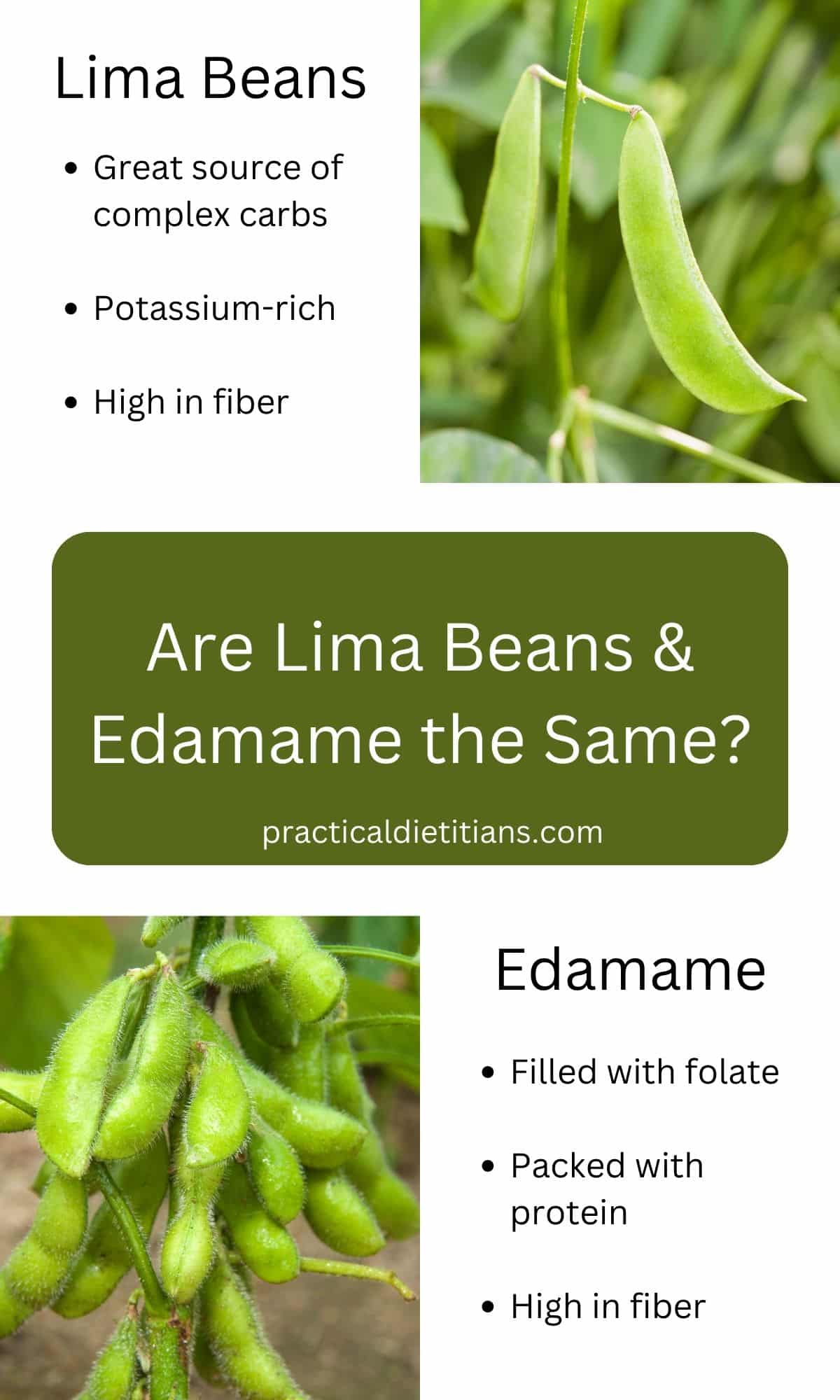Lima beans and edamame look similar, but they are not the same. Both of these plant foods provide quality additions to your meals, but they vary nutritionally.
Notable differences are protein, carbs, calcium, folate, and vitamin K content. Lima beans are higher in carbs, while edamame is higher in protein, calcium, folate, and vitamin K.
Both bean types provide vital nutrients for women to help preserve their muscles. They are also low in sodium and rich in carbs for energy and fiber for digestive health, making them nutritious choices for your eating pattern.
The micronutrients provided from these green legumes include heart-healthy potassium and magnesium, which women often lack.
A ½ cup portion of lima beans provides
- 105 calories
- 6 grams protein
- 20 grams carbs
- 5 grams fiber
- 27 mg calcium
- 2 mg iron
- 63 mg magnesium
- 485 mg potassium
- 14 mg sodium
- 22 mcg folate
- 5 mcg vitamin K
A ½ cup portion of shelled edamame provides
- 94 calories
- 9 grams protein
- 7 grams carbs
- 4 grams fiber
- 49 mg calcium
- 2 mg iron
- 50 mg magnesium
- 338 mg potassium
- 5 mg sodium
- 241 mcg folate
- 21 mcg vitamin K

Lima beans and edamame comparison
Mukimame vs edamame
Mukimame is a name you may see in the freezer section when looking for shelled edamame. It is the same as edamame without the shell. For convenience, you may prefer this option.
What do lima beans and edamame taste like?
Lima beans are soft, smooth, buttery, and mild in flavor, similar to a pinto bean’s texture but have a fresh “green” taste.
Edamame, on the other hand, has a firmer nutty bite, like a peanut that has been soaked, and the flavor is mild and fresh. Both beans are delicious and enjoyed by many.
What is edamame?
The scientific name of edamame is Glycine max. Originating in Asia, edamame is a vivid, bright green soybean that is harvested before maturing. This legume is a great way to reap the benefits of soy foods.
Another name for edamame
The Chinese refer to this food as a hairy bean or mao dou. The word edamame in Japanese translates to beans on a branch. This bean is also referred to as a stem bean.
Edamame health benefits
Edamame is helpful for older women due to its rich fiber, potassium, and folate content. Adequate intake of these nutrients helps decrease the risk of heart disease and certain cancer types.
How do you eat edamame?
Edamame is a fun food that can be steamed in the pods and eaten from them, making it entertaining. The pod is leathery and should not be eaten. We tried it and it was too tough to chew.
You can get already shelled edamame (mukimame) to steam or boil and serve with your meals to add a boost of nutrients. It’s a delightful addition to sushi rolls, added to salads, or consumed as a snack.
Can you eat edamame raw?
In our literature review, we did not find any evidence that it is safe to eat edamame raw, right off the plant. We recommend cooking the product before consuming it.
Can you eat lima beans raw?
Due to the antinutrient content of raw lima beans, consuming them is not safe. Antinutrients are substances such as oxalate, lectin, and phytate that can be toxic or interfere with our digestion and nutrient absorption.
Soaking and cooking the beans reduces the antinutrients to safe levels.
What are lima beans?
The scientific name for lima beans is Phaseolus lunatus. It is also called a sieva bean. Originating in Central and South America, these pale green legumes are also referred to as butter beans.
In some parts of the United States, butter beans and lima beans are seen as distinct from one another even though they are of the same species. Butter beans tend to be prepared from dried and have a yellowish color.
The green variety is considered immature and is usually called lima beans.
Conclusion
Both of these mild flavored beans are nutritious for women giving us vital nutrients. If you struggle to consume an adequate amount of protein, you can keep frozen edamame on hand for a quick “add” to your dishes.
You can decide which you like better based on your preferences. Edamame has a firm nutty bite while lima beans are softer. For convenience, you might like to use mukimame for your meals and snacks.
For more information, we invite you to read our blog on the Facts about Soybeans.
And for tips on adding pizzaz to your meals, grab your copy of our Herbs & Spices ebook on this page!


